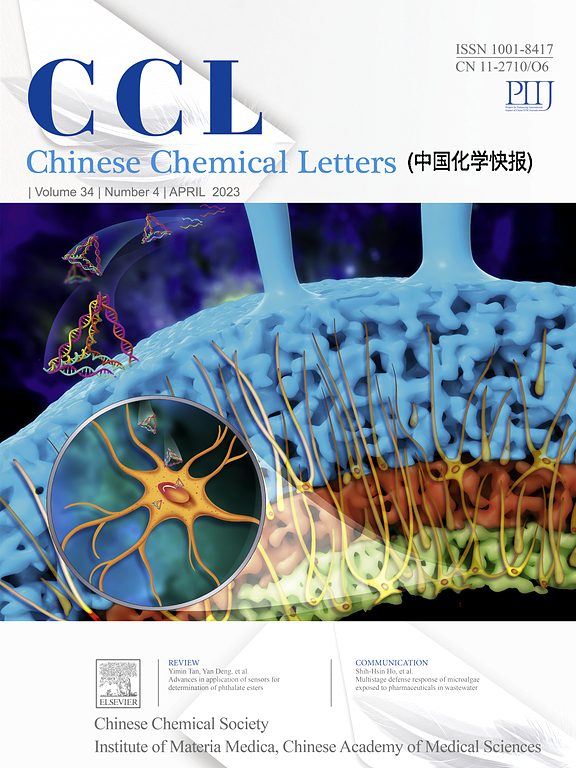有机催化N-[(α-三氟甲基)乙烯基]isatins CN键活化绿色合成2-三氟甲基喹啉骨架
IF 9.4
1区 化学
Q1 CHEMISTRY, MULTIDISCIPLINARY
引用次数: 0
摘要
Pfitzinger反应一直是合成喹啉-4-羧酸的重要途径。虽然自138年前发现以来,人们就认识到它的合成潜力,但直到现在,真正的催化变体仍然难以捉摸。在此,我们提出了一种新的2-叔丁基- 1,1,3,3-四甲基胍(BTMG)催化的Pfitzinger反应,该反应使用N-[(α-三氟甲基)乙烯基]isatins与胺和醇,为2- cf3 -喹啉-4-羧胺和羧酸酯提供了直接途径。该方法不仅绿色环保,而且可以在喹啉骨架的C2位置引入CF2H、CO2Me等其他官能团。广泛的底物范围、商业药物的后期修饰和喹啉框架的多种衍生化证明了这种方法的实用性。更重要的是,这项工作不仅为酰胺CN键的活化在催化反应发展中开辟了一条新的途径,而且还解锁了一些对PTP1B具有强抑制活性的2-三氟甲基喹啉或在有机发光二极管中的光电应用的巨大潜力。本文章由计算机程序翻译,如有差异,请以英文原文为准。
![Green synthesis of 2-trifluoromethylquinoline skeletons via organocatalytic N-[(α-trifluoromethyl)vinyl]isatins CN bond activation](https://img.booksci.cn/booksciimg/2024-11/102303375141776791643.jpg)
Green synthesis of 2-trifluoromethylquinoline skeletons via organocatalytic N-[(α-trifluoromethyl)vinyl]isatins CN bond activation
The Pfitzinger reaction has long served as a notable synthesis pathway for quinoline-4-carboxylic acids. Although recognized for its synthetic potential since its discovery >138 years ago, a truly catalytic variant has remained elusive until now. Herein, we present a novel 2‑tert‑butyl‑1,1,3,3-tetramethylguanidine (BTMG)-catalyzed Pfitzinger reaction that employs N-[(α-trifluoromethyl)vinyl]isatins with amines and alcohols, providing direct routes to 2-CF3-quinoline-4-carboxamides and carboxylic esters. This method is not only green and environmentally benign but also accommodates the introduction of other functional groups like CF2H and CO2Me at the C2 position of quinoline skeleton. The utility of this methodology was demonstrated by the broad substrate scope, the late-stage modification of commercial drugs, and the diverse derivatization of quinoline framework. More importantly, this work not only opens up a new avenue for the activation of amide C![]() N bonds in catalytic reaction development, but also unlocks the huge potential of some 2-trifluoromethyl quinolines with strong inhibitory activity against PTP1B or optoelectronic application in organic light-emitting diodes.
N bonds in catalytic reaction development, but also unlocks the huge potential of some 2-trifluoromethyl quinolines with strong inhibitory activity against PTP1B or optoelectronic application in organic light-emitting diodes.
求助全文
通过发布文献求助,成功后即可免费获取论文全文。
去求助
来源期刊

Chinese Chemical Letters
化学-化学综合
CiteScore
14.10
自引率
15.40%
发文量
8969
审稿时长
1.6 months
期刊介绍:
Chinese Chemical Letters (CCL) (ISSN 1001-8417) was founded in July 1990. The journal publishes preliminary accounts in the whole field of chemistry, including inorganic chemistry, organic chemistry, analytical chemistry, physical chemistry, polymer chemistry, applied chemistry, etc.Chinese Chemical Letters does not accept articles previously published or scheduled to be published. To verify originality, your article may be checked by the originality detection service CrossCheck.
 求助内容:
求助内容: 应助结果提醒方式:
应助结果提醒方式:


